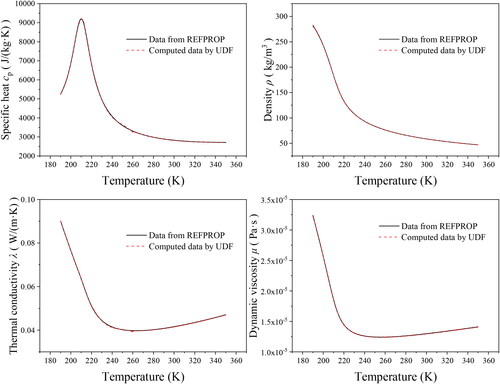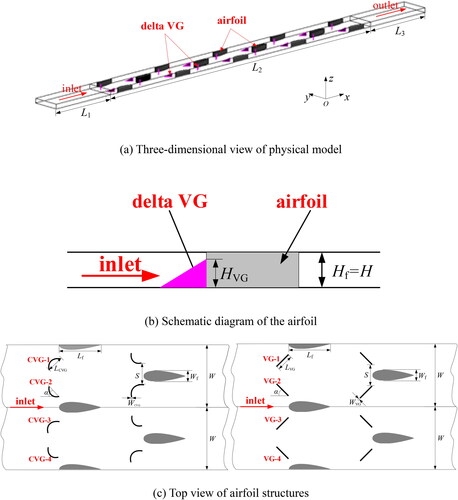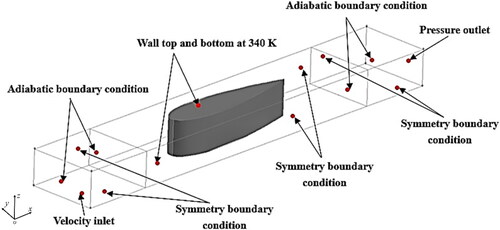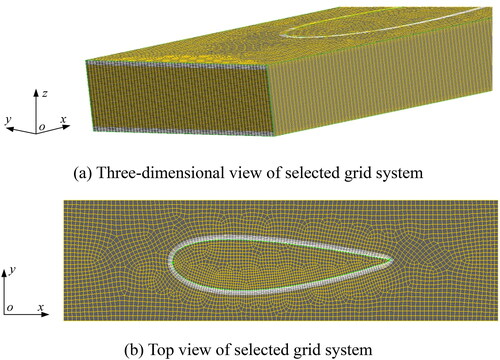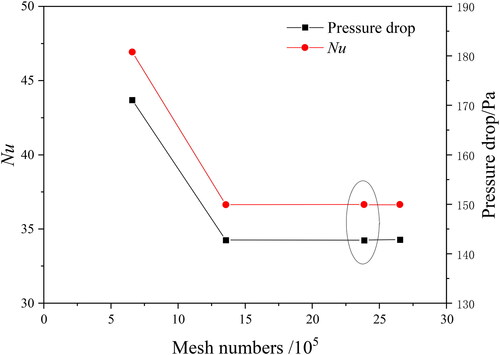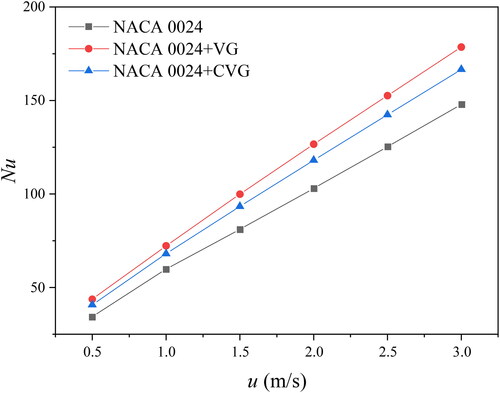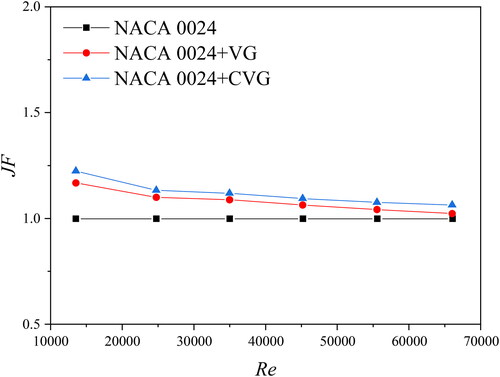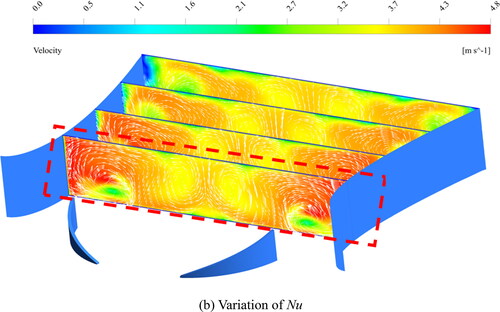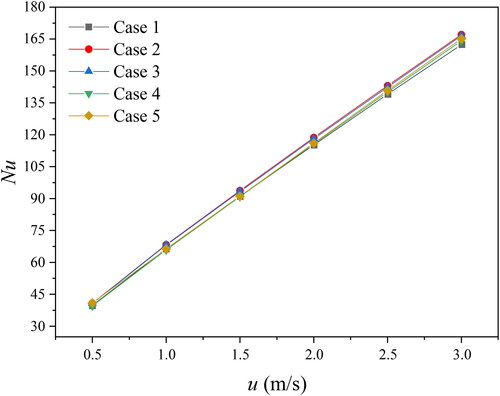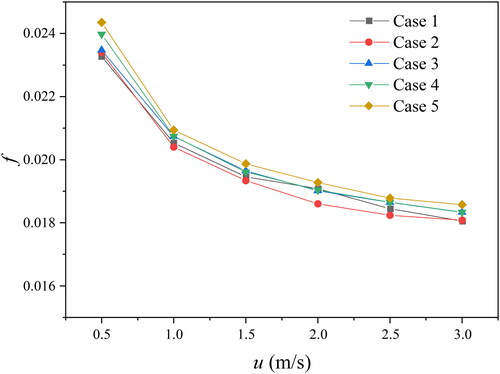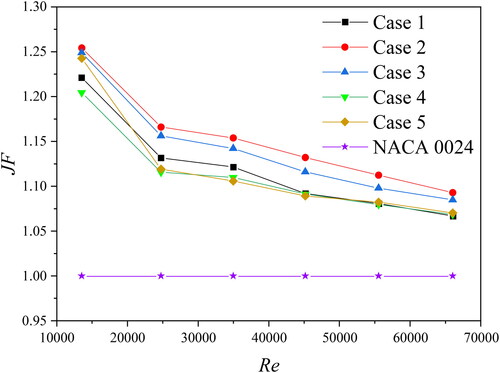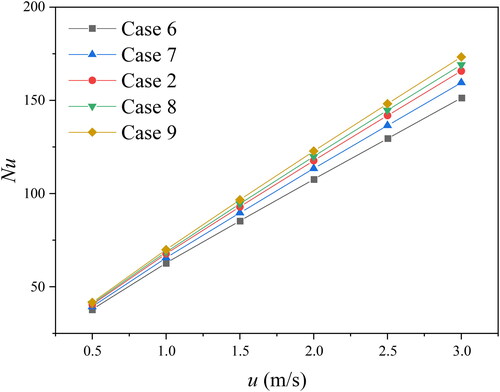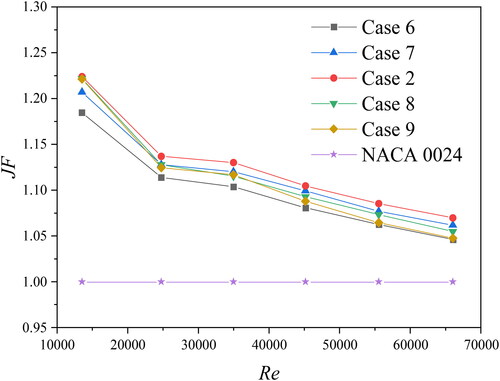 ?Mathematical formulae have been encoded as MathML and are displayed in this HTML version using MathJax in order to improve their display. Uncheck the box to turn MathJax off. This feature requires Javascript. Click on a formula to zoom.
?Mathematical formulae have been encoded as MathML and are displayed in this HTML version using MathJax in order to improve their display. Uncheck the box to turn MathJax off. This feature requires Javascript. Click on a formula to zoom.Abstract
In this study, the effects of fin configurations and layouts on thermal and hydraulic performances in a printed circuit heat exchangers with supercritical liquefied natural gas as the working fluid are numerically studied, and the overall heat transfer performance is evaluated by the thermal performance factor. Firstly, the effect of three different airfoil configurations, that is, NACA 0024, NACA 0024 with vortex generator, and NACA 0024 with curved vortex generator (CVG) is investigated. The comparative results indicate that NACA 0024 and CVG combined configurations offer the best overall heat transfer performance. Furthermore, the effect of the CVG minimum transverse distance is analyzed in detail. The results show that for a given CVG configuration, the CVG minimum transverse distance should not be too small or too large, so that the longitudinal vortices (LVs) generated will not interact with each other and the LVs’ influences may reach a longer distance. The optimal CVG minimum transverse distance is 1.75 of maximum airfoil thickness. Finally, the effect of CVG attack angle is studied. The results indicate that the optimal CVG attack angle of combined configurations is 45° for improving the overall heat transfer performance, and an optimal CVG and airfoil fin arrangement is suggested.
Introduction
Natural gas (NG) is well-known as one of the cleanest form of fossil fuels, and it is the fastest growing primary energy source owing to its advantages such as clean and efficient combustion, reliable and durable supply, energy and specific density, convenient and clean usage, and flexible implementations [Citation1]. The demand for a compact and high-efficiency heat exchanger has been high in various industries, and it is considered an essential item, especially in ships used for transporting large amounts of gas. Nowadays, the demand for liquified natural gas (LNG) carriers and floating storage regasification units (FSRUs), one of the related ships, is increasing worldwide. Process technology for LNG-FSRU can be presented as follows: LNG is transferred into a cargo tank by a dedicated LNG feed pump, then LNG is sent to high-pressure booster pump which is used to enable high-pressure before entering the LNG vaporizer, after that LNG will be vaporized and sent to end user [Citation2]. Four main kinds of LNG vaporizers are commercially available, i.e., intermediate fluid vaporizer, open rack vaporizer, super open rack vaporizer, and submerged combustion vaporizer. However, the heat exchangers for LNG-FSRU should be more compact than the ones in onshore liquefaction plants due to its limited platform area [Citation3].
A printed circuit heat exchanger (PCHE) is a newly developed heat exchanger which is manufactured by diffusion bonding heat plates with chemically etched microchannels. Thus, it provides a high surface density more than 1000 m2/m3 which is about 1/6 times smaller than shell-and-tube heat exchangers and durability of up to 60 MPa. Due to the favorable characteristics of compactness, its potential to further penetrate the market is rather substantial, especially if the heat exchanger size, weight, and endurance are major concerns [Citation4].
During the past few years, many researchers spent considerable efforts to study thermal and hydraulic performances of PCHEs. The common flow channels of PCHEs are straight channels, wavy channels, zigzag channels, S-shaped channels, and channels with airfoils. Jeon et al. [Citation5] proposed an innovative type of PCHE, and the effect of channel sizes of heat source fluid and heat sink fluid, the spacing between the channels, and the channel cross-sectional shape on the thermal performance was analyzed. Chen et al. [Citation6] experimentally investigated the thermal and hydraulic performance of a zigzag channel PCHE in a high-temperature helium test facility at the Ohio State University. New thermal-hydraulic correlations for current zigzag channels with rounded bends were developed based on the experimental data. Compared to thermal performance in straight channels, zigzag channels provided a small advantage in the laminar flow regime but a significant advantage near the transition flow regime. Ma et al. [Citation7] studied the thermal and hydraulic performance of zigzag-type PCHE with helium as the working fluid operating at a typical temperature of 900 °C in a very high-temperature reactor. The results showed that the flow and temperature at high temperature could not achieve a fully developed condition due to the significant variation of the thermal physical properties arisen from the large temperature difference. Considering the huge pressure loss caused by a zigzag channel, Ngo et al. [Citation8] proposed a new channel called the S-shaped channel applied to a hot water supplier in which cold water was heat-exchanged with supercritical CO2. It was found to provide about 3.3 times less volume, and reduced pressure drop by 37% on the CO2 side and by 10 times on the H2O side. The effects of the waviness factors in a wavy channel PCHE, e.g., the amplitude and the period, on the thermal performance of the PCHE were investigated numerically by Baik et al. [Citation9]. Compared with the thermal performance of conventional straight channel PCHEs, the wavy channel PCHEs had significantly higher thermal performance than the conventional straight channel PCHEs due to the increased heat transfer area. Lian et al. [Citation10] designed a new hybrid PCHE structure that used chemical-etching channels for the supercritical carbon dioxide side and plate-fin channels for the waterside. Compared with the conventional PCHE, the core volume of the optimized hybrid PCHE was reduced by 49%, and the heat transfer rate per unit volume was increased by 145%. Chang et al. [Citation11] proposed a novel annular air-hydrogen precooler based on the PCHE. Segmented thermal design method and genetic algorithm were used for structure optimization. The results indicated that the novel precooler had higher compactness and volumetric power. Ma et al. [Citation12] established a numerical model to study the thermal and hydraulic characteristics of transcritical natural gas in the PCHE in rolling conditions. The results showed that the rolling condition had minor effects on the total heat transfer rate, but significantly affected the local friction factor and heat transfer characteristics. Kim et al. [Citation13] designed an airfoil fin to optimize the thermal and hydraulic performance of a PCHE. The pressure drop of the airfoil fin could be reduced to one-twentieth of that of the zigzag channel but the total heat transfer rate per unit volume was almost the same. Tsuzuki et al. [Citation14] obtained an optimal flow channel configuration considering the thermal and hydraulic performance by changing the fin shape and angle parametrically. The new configuration had discontinuous fins with an S-shape, like a sine curve, in contrast to a conventional continuous zigzag configuration, and the new configuration had one-fifth of the pressure drop compared to the conventional zigzag configuration with equal thermal and hydraulic performance. Yoon et al. [Citation15] compared the overall heat transfer performance of four different PCHEs, which were straight, zigzag, S-shape, and airfoil PCHEs. The comparison results showed that the airfoil PCHEs provided the best overall heat transfer performance. Ma et al. [Citation16] numerically studied the effect of the fin-endwall fillet on the thermal and hydraulic performance of a PCHE with airfoil fins. It was found that the fin-endwall fillet could increase heat transfer and pressure drop for the case with the non-dimensional longitudinal pitch being 1.63. The effect of fin-endwall fillet on the thermal and hydraulic performance decreased with increase of the transverse pitch, but the longitudinal pitch had little effect when the non-dimensional longitudinal pitch was greater than 1.88. Chu et al. [Citation17] studied the hydraulic and thermal performances of printed circuit heat transfer surface with distributed airfoil fins. The results showed that the heat transfer rate decreases because of the strong variation of the properties of supercritical CO2, but the pressure loss remained almost constant along the main flow direction. It was proved that a large windward area and a short length could lead to better heat transfer performance. Cui et al. [Citation18] proposed two novel fins based on the configuration of National Advisory Committee for Aeronautics (NACA) 0020 airfoil, to further improve the performance of a zigzag channel PCHE with airfoil fins. Chu et al. [Citation19] numerically investigated thermal-hydraulic performances of PCHEs with cambered NACA four-digit airfoil fins used as the condenser in a supercritical CO2 Brayton power cycle. From the above review, it is concluded that the thermal performance may be enhanced by non-straight channels, especially channels with airfoil fins.
On the other hand, using a vortex generator (VG) is a common passive technology for improving heat transfer performance. The geometric shape of VG is an important contributory factor to heat transfer enhancement. Kashyap et al. [Citation20] numerically studied thermal and hydraulic performances of VGs with surface textures. The results showed that a VG with concave semi-circular texture on the leading surface yielded the highest enhancement in Nusselt number (14.4%) with a 3.24% rise in the pressure coefficient. It also provided a 3.3% reduction in the drag coefficient compared to a simple rectangular VG. Li et al. [Citation21] numerically investigated thermal and hydraulic performances of a fin-and-tube heat exchanger, and the position and the geometric dimensions of the VGs were optimized. The simulation results showed that the Colburn j-factor and the friction factor both increased with the VG number. The fin structure had the best comprehensive performance when its VGs were uniformly arranged both in the upwind and backwind regions of the tubes. With the increase of the VG length, the comprehensive performance factor JF became lower. Zhou et al. [Citation22] experimentally investigated thermal and hydraulic performances of a plane and curved winglet VGs with and without punched holes. The results showed that curved winglet-type VGs had better heat transfer enhancement and lower flow resistance than corresponding plane winglet VGs in both laminar and turbulent flow regions. The punched holes could improve thermal and hydraulic performances of VGs and decrease the flow resistance for all cases. The optimal diameter of the holes needed to be matched with the VG face area, i.e., the smaller the VG face area, the relatively smaller hole diameter was better. Göksu et al. [Citation23] experimentally investigated the effect of a novel curved winglet VG on heat transfer with a designed controller circuit. Considering the results obtained with the elements placed in the pipe, the highest increases in Nusselt number and friction factor compared to the smooth pipe were 173% and 592%, respectively. The results showed that the highest heat transfer increase was achieved with the double-sided opened blade. Oh et al. [Citation24] numerically compared thermal and hydraulic performances of the rectangular-winglet, delta-winglet-upstream, and delta-winglet-downstream curved VGs. Based on the numerical results, it was found that when curved VGs were placed at α = 30°, mixed vortices were generated, thereby improving the thermal performance of the fin. Furthermore, a secondary flow was induced enhancing the fin thermal performance. In contrast, placing the curved VGs near the rear of the tube reduced the wake size and increased heat transfer behind the tube. Song et al. [Citation25] proposed a novel configuration of two pairs of concave curved vortex generators. They numerically studied the effect of the concave curved vortex generator pairs with different transverse locations and attack angles on the thermal-hydraulic characteristics of the heat exchanger. The multi-objective optimization and a neural network were adopted to optimize the vortex generator arrangements for the best heat transfer capacity. At the optimal Pareto front, the optimal heat transfer capacity was increased by 35.7% under the same pumping power. Hu et al. [Citation26] numerically studied the effect of different transverse locations of the concave curved vortex generators on thermal performance. The results showed that the staggered-arranged concave curved vortex generators could generate counter-rotating longitudinal vortices and enhance heat transfer. The Nusselt number and thermal performance of the proposed vortex generator arrangement could be increased by 30.4% and 25.9%, respectively.
According to the studies above, the combined configuration of VGs and airfoil fin may bring greater heat transfer enhancement. In this study, based on a numerical study of the effect of different combined configurations on thermal and hydraulic performances in a PCHE using supercritical LNG as a working fluid, ways to improve thermal and hydraulic performances and the direction of optimizing the fin structure are revealed. The results may provide practical guidance on the heat transfer enhancement method for LNG vaporization devices in the supercritical LNG heat exchange process.
Methodology
Physical properties
Methane is the major chemical component of LNG. As is well known, gas exists as a single-phase medium when the pressure and temperature is above the critical state, so the phase change phenomenon of methane no longer happens when its pressure and temperature is above 4.59 MPa and 190.56 K. The thermal-physical properties of methane, i.e., specific heat cp, density ρ, thermal conductivity λ, and dynamic viscosity μ, are calculated by REFPROP at 8.0 MPa. In comparison with the traditional fluid flow and heat transfer behavior, the thermal-physical properties of supercritical methane change dramatically with temperature as shown in . The variations of the thermal-physical properties with temperature can be expressed by the user-defined function (UDF) in ANSYS FLUENT 19.0, and the deviations between data from REFPROP and the computed data by UDF are within ±2%.
Physical model and data reduction
A three-dimensional heat exchanger unit is designed to implement the numerical simulations, as shown in . The methane flow is described in a coordinate system, in which x, y, and z are streamwise, spanwise, and normal coordinates, respectively. Channel height H is 1.0 mm, and the channel width W is 2.0 mm. A 4-digit NACA airfoil fin is described by three dimensions: the height (Hf), the maximum thickness (Wf), and the chord length (Lf), as shown in .
shows the calculation domain and the installation position of the CVGs. There are two delta winglet concave CVGs with each airfoil fin. From the mechanism of chemical etching, processing cost does not increase with the complexity of the airfoil structure, which ensures the availability of airfoil fins. However, considering the operability of chemical etching, the channel depth is kept at 0.5–1.0 mm (etched deeper, more serious side etching) [Citation27]. In this study, Hf = 1 mm, and Lf = 4 mm. To support a uniform velocity at the inlet and suppress the backflow at the outlet, the channel lengths (L1, L2, L3) are 15.0 mm, 72.0 mm, and 30.0 mm, respectively.
The Reynolds number (Re) is defined as
(1)
(1)
where umax is the velocity of methane evaluated at the minimum cross-section, m is the mass flow rate, and Amin is the minimum cross-section area in the channel. ρ is the density of methane, and μ is the dynamic viscosity of methane, which are evaluated at the mean temperature of methane. Dh is the hydraulic diameter and is defined by
(2)
(2)
where P is the wetted perimeter.
The convective heat transfer coefficient can be calculated by
(3)
(3)
The mean Nusselt number (Nu) is defined as
(4)
(4)
The Darcy friction factor (f-factor) reflects the pressure drop of the channel and is given as
(5)
(5)
where Δpf is the frictional pressure drop and L2 is the length of the channel. The frictional pressure drop Δpf can be obtained by
(6)
(6)
(7)
(7)
where Δp is the total pressure drop, and Δpa is the acceleration pressure drop. ρin, uin and ρout, uout are the density and velocity evaluated at the inlet and outlet of the channels, respectively.
The Prandtl number Pr is defined as
(8)
(8)
The mean Colburn factor (j-factor) is defined as
(9)
(9)
The JF factor can be calculated by
(10)
(10)
where the subscript ref is the reference channel. Therefore, the JF factor, related to the j and f factors, is a dimensionless number of the larger-the-better characteristics and is evaluated as thermal and hydraulic performance for the studied cases.
Numerical method
The governing equations for continuity, momentum, and energy may be expressed in tensor notation as
(11)
(11)
In the above equation, the dependent variable, ϕ, stands for the velocity components, temperature, k and ε. The terms Γϕ and Sϕ represent the appropriate diffusion coefficients and the source terms, respectively. The expressions for ϕ, Γϕ and Sϕ [Citation28] are summarized in .
Table 1. Expressions for ϕ, Γϕ and Sϕ.
The supercritical methane flow in the computational domain is regarded as three-dimensional, turbulent, and quasi-steady. The boundary conditions for the computational model are shown in . The flow channels formed by the fins are symmetrical in the longitudinal direction, so a symmetry condition is used for the x-z plane in this study. The flow velocity uin is assumed to be uniform, the temperature Tin is taken as 195 K, and pressure is specified at the outlet of the channels. On the solid surfaces, no-slip conditions are used, and a constant temperature of 340 K is applied at the top and bottom surfaces of the channels. The temperature distribution in the fins will be determined by solving the conjugated heat transfer problem between supercritical methane and the fins in the computational domain.
The governing equations and boundary conditions are solved by Ansys Fluent 19.0. A preprocessor Gambit 2.4 is used to mesh the computational domain for the solver. To control the mesh number and improve the grid quality, a hexahedral grid is used for meshing as shown in . Due to the stringent requirements for the boundary grid density under supercritical flow and heat transfer, five boundary layers are used near the top and bottom walls and fin surfaces, with the thickness of the first layer being 0.01 mm.
All variables, including velocity components, pressure, and temperature, are averaged for a control volume. The coupling between pressure and velocity is implemented by the semi-implicit method for pressure-linked equations (SIMPLE) algorithm. The quadratic upstream interpolation for convective kinematics (QUICK) method is used to discretize the convection terms. The residuals are set to be less than 10−5 and 10−8 for continuity, momentum, and energy equations, respectively, to ensure convergence of the computations. shows the results of the grid independence check. After validating the solution independence of the grid number, the reference grid systems for the PCHE with airfoil fins are about 2,385,920 cells.
Code validation
To validate the reliability of the numerical simulation procedure, a model set up from the experiments of Liu et al. [Citation29] is simulated with the shear stress transport (SST) k–ω turbulence model, at the same operating conditions as in the experiments, and compared with the experimental correlations near the pseudo-critical temperature. The thermal-hydraulic correlations used for comparison are described as
(12)
(12)
(13)
(13)
shows comparisons between the simulation results and the experimental results. Compared with the experimental results, the mean relative deviations of the Nusselt number and f-factor are −6.8% and −4.9%, respectively. The simulation results using the SST k–ω turbulence model have good agreement with the experimental results, so the SST k–ω turbulence model is adopted in this study.
Figure 6. Nu and f-factor comparisons between simulated and experimental results of Liu et al. [Citation29].
![Figure 6. Nu and f-factor comparisons between simulated and experimental results of Liu et al. [Citation29].](/cms/asset/bca3f74e-41fb-4218-9b33-dc9389596641/uhte_a_2249729_f0006_c.jpg)
Results and discussion
Thermal and hydraulic performance comparisons for different airfoil configurations
The effect of three different configurations on the thermal and hydraulic performance, i.e., NACA 0024, NACA 0024 with VG, and NACA 0024 with CVG, is first investigated. The VG of these configurations is different, and the other geometric parameters are listed in .
Table 2. Geometric parameters of different PCHE configurations.
Tang et al. [Citation30] numerically investigated the thermal and hydraulic performances of PCHE at different supercritical LNG operating pressures. The results indicated that the heat transfer performance was reduced as the pressure increased, while the friction factor was increased when the operating pressure increased from 7.0 MPa to 10.0 MPa. A moderate inlet pressure of LNG is chosen to investigate effects on the thermal and hydraulic performances of fin configurations and layouts in this study. The inlet pressure for different airfoil configurations is set as 8.0 MPa, and the inlet velocities are set as 0.5, 1.0, 1.5, 2.0, 2.5, and 3.0 m/s, respectively. Thermal and hydraulic performances of different airfoil configurations are compared in and , where the inlet velocity of the channels is taken as the abscissa.
As can be seen from and , the Nusselt number of three airfoil configurations increases with the increase of inlet velocity, while the f-factor decreases with the increase of inlet velocity. At the same inlet velocity, heat transfer enhancement in descending order is NACA 0024 with VG, NACA 0024 with CVG, and NACA 0024. and the associated penalty of pressure drop in descending order is NACA 0024 with VG, NACA 0024 with CVG, and NACA 0024. As is known, VG and CVG can generate longitudinal vortices (LVs). The LVs generated can provide better thermal performance, but the corresponding pressure drop is also increased.
As mentioned above, NACA 0024 with VG provides the best heat transfer performance and the largest pressure drop. Attention is now turned to compare the overall heat transfer performance of different airfoil configurations. The comparison results are shown in , where the Reynolds number is taken as the abscissa. It can be seen clearly that NACA 0024 with CVG offers the best overall heat transfer performance, next is NACA 0024 with VG, while NACA 0024 has the worst overall heat transfer performance. NACA 0024 with CVG can enhance the overall heat transfer performance and is adopted in the following studies.
Effect of the CVG minimum transverse distance
Two kinds of VG array arrangements and a conventional arrangement were comprehensively and comparatively investigated by He et al. [Citation31], and the results showed that the front arrangement of VGs could achieve larger heat transfer enhancement. Therefore, CVGs are arranged upstream the airfoils in this study. According to a previous study [Citation32], the best delta VG height and delta VG length are about 0.5H and 1.5H, respectively. Therefore, CVG attack angle, CVG height, and CVG length in this study are set as 45°, 0.5 mm, and 1.5 mm, respectively. In this section, the effect of the CVG minimum transverse distance of five different CVG and airfoil combined configurations, as shown in , on thermal and hydraulic performances is investigated. The CVG minimum transverse distance S varies from 1.0 Wf to 2.5 Wf, and the other geometric parameters of these five cases are listed in .
Table 3. Geometric parameters of different CVG and airfoil combined configurations.
and present the velocity distributions at different cross-sections along the x-direction in the 9th row at uin=1.5 m/s. From , two kinds of LVs are generated at the leading edges and survive in the longitudinal direction. This is because there are two kinds of CVG configurations in , that is, CVG-2 and CVG-3 making up the common-flow-up CVG configuration, and CVG-2 and CVG-1 making up the common-flow-down CVG configuration. The counter-rotating pairs of outside vortices are generated by the common-flow-up CVG configuration. LVs 1 rotates in a clockwise direction and LVs 4 rotates in a counterclockwise direction. Meanwhile, the counter-rotating pairs of inside vortices are generated by the common-flow-down CVG configuration. LVs 2 rotate in a counterclockwise direction and LVs 3 rotate in a clockwise direction. These four vortices induce strong swirling motion and destroy the boundary layer. Accordingly, they may greatly enhance heat transfer.
Figure 11. Velocity distributions at the different cross sections in the 9th row of different cases at uin=1.5 m/s.
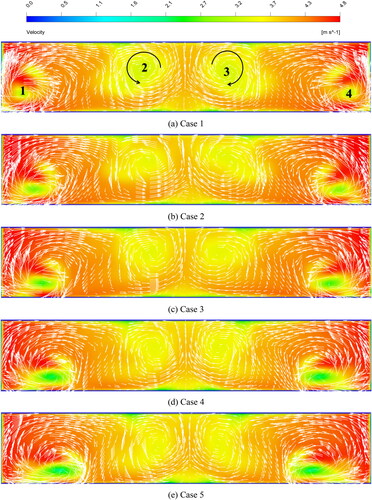
Thermal performance comparisons for different VG minimum transverse distances are shown in . As can be seen from , with the increase of the inlet velocity, the Nusselt number increases. At the same inlet velocity, the Nusselt number of Case 2 is the largest, the next is Case 3, Case 5, and Case 4 in descending order, and the last one is Case 1.
Hydraulic performance comparisons for different CVG minimum transverse distances are shown in . From , with the increase of inlet velocity, the f-factor decreases. At the same inlet velocity, the f-factor of Case 5 is the largest, then Case 4, Case 3, Case 1, and Case 2 in descending order. The reason can be explained as follows. The flow friction performance is affected by the two kinds of LVs, and the skin friction perturbation of the common-flow-down cases is much larger than that of the common-flow-up cases when the fluid flows through the CVG pairs because there is a stronger interaction effect on the wall. The spanwise component of the skin friction of the common-flow-down cases is much larger, and the spanwise skin friction of the common-flow-up cases will decrease even more as the vortices continue to lift each other away from the wall. In , with the increase of S, the minimum transverse distance of the common-flow-down VG configuration decreases. In addition, the distance between the airfoil wall and the core of LVs 1 increases, and the distance between the core of LVs 1 and the core of LVs 2 decreases. From , it can be observed that LVs 1 and LVs 4 of Case 1, Case 2, and Case 3 are more intensive than those of Case 4, so the spanwise skin friction is smaller than that of Case 4, and this can give more compensation for the increase of pressure drop. Due to the stronger interaction between the fluid and the airfoil wall, the hydraulic performance of Case 1 is worse than that of Case 2. For Case 5, the interactions of LVs 1 and LVs 2, LVs 2 and LVs 3, and LVs 3 and LVs 4 are stronger than those of Case 4, so the friction performance of Case 5 is worse than that of Case 4.
shows the comparison results of the JF factor for these five cases. The reference channel is a straight PCHE with NACA 0024 airfoil fins. It can be seen clearly that Case 2 offers the best overall heat transfer performance. Therefore, for a given CVG configuration, the CVG minimum transverse distance should not be too small or too large, so that the two kinds of LVs generated will not interact with each other and the LVs’ influences may last a longer distance.
Compared with the straight PCHE with NACA 0024 airfoil fins in the range of the studied Reynolds number, the mean relative deviations of the JF factor of Case 1, Case 2, Case 3, Case 4, and Case 5 are 11.8%, 15.2%, 14.0%, 11.2%, and 11.8%, respectively. The optimal CVG minimum transverse distance for PCHEs with CVG and airfoil fins is 1.68 mm. As mentioned above, Case 2 can provide the best overall heat transfer performance and is adopted in the following studies.
Effect of the attack angle α
In this section, the CVG and airfoil combined configurations with S = 1.68 mm are selected for investigating the effect of attack angles on the heat transfer and pressure drop characteristics. The CVG attack angle α varies from 35° to 55°, and the other geometric parameters of the five cases are listed in .
Table 4. Attack angle of different CVG and airfoil combined configurations.
shows that as the attack angle increases, the thermal performance increases monotonically. This is because as α increases, the CVGs further disturb the flowing fluid, and this results in higher heat transfer performance. However, the improvement in heat transfer performance by increasing the attack angle will be at the cost of a larger pressure drop.
and show the velocity contour at different cross-sections along the z-direction in the 8th and 9th row at uin=1.5 m/s. As can be seen from , the flow direction of supercritical methane upstream the CVG is changed, and LVs are generated downstream the CVG when supercritical methane flows over the CVG, and this can destroy the boundary layer effectively. It can also be seen that a proper increase of the attack angle can provide higher velocity along the CVG, especially Case 2, Case 8, and Case 9. As is well known, the higher velocity can greatly improve the capability of supercritical methane for heat transfer enhancement. This means that the arrangement of CVGs should be properly designed to further enhance heat transfer.
Figure 16. Velocity contours at the central cross section in the z direction of Case 2 at uin=1.5 m/s.

Figure 17. Velocity contours at the central cross section in the z direction of other cases at uin=1.5 m/s.
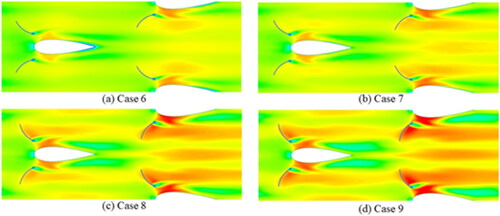
The results of Eibeck and Eaton [Citation33] imply that the LVs impose local modifications in the heat transfer coefficient through distortion of the mean flow rather than by modifying the turbulence field or by the larger skin friction magnitude caused by the spanwise flow. The distortion intensity of the mean flow can be defined as
(14)
(14)
shows the variations of P′ for Case 6, Case 7, Case 2, Case 8, and Case 9 in the 9th row at uin = 1.5 m/s. As can be seen in , the curve for the channels with CVG and airfoil fins has a sudden increase at the position of CVG's forefront. As mentioned earlier, when the fluid flows over CVGs, the LVs are generated at the leading edge of CVGs. The distortion intensity approaches its peak value at the trailing edge of CVGs, and then gradually decreases behind CVGs. The vortices decay downstream due to viscous dissipation. When the fluid flows over the airfoils, the distortion intensity will approach the peak value again.
The mean intensities of the LVs generated in Case 2, Case 8, and Case 9 are 52.0%, 85.0%, and 130.3% higher than Case 6, respectively. This is the reason why an increase in the attack angle can provide the best heat transfer performance.
displays the friction factor of different PCHEs vs. uin. It can be observed that the larger attack angle can induce a higher flow resistance. This can be explained as follows. As α increases, the disturbance of CVG on the flowing fluid increases, and the transverse velocity of the fluid increases. It results in a reduction in the fluid velocity in the x-direction and an increase in flow resistance. Within this work scope, the average friction factor increases by about 12.9% when the attack angle increases from 35° to 55°.
The comprehensive performance of PCHEs with different attack angles is compared in . It can be seen clearly that Case 2 offers the best overall heat transfer performance. Compared with the straight PCHE with NACA 0024 airfoil fins in the range of the studied Reynolds number, the mean relative deviations of the JF factor of Case 6, Case 7, Case 2, Case 8, and Case 9 are 9.8%, 11.5%, 12.5%, 11.4%, and 11.0%, respectively. This means that a proper increase in the attack angle can be an effective way to improve the comprehensive performance of the PCHE. However, the CVG attack angle should not be too small or too large. In this study, Case 2 is the best-combined configuration.
Conclusions
This study compares the effects of different airfoil configurations on the thermal and hydraulic performances of supercritical LNG by three-dimensional numerical simulations. The main conclusions can be summarized as follows:
The effect of three different airfoil configurations, that is, NACA 0024, NACA 0024 with VG, and NACA 0024 with CVG, is first investigated on the thermal and hydraulic performances. The comparative results indicate that NACA 0024 with CVG offers the best overall heat transfer performance, next is NACA 0024 with VG, while NACA 0024 has the worst overall heat transfer performance. This means that the structure of VG should be properly designed to further enhance heat transfer.
Moreover, the effect of the VG minimum transverse distance on the thermal and hydraulic performances is investigated. Compared with the straight PCHE with NACA 0024 airfoil fins in the range of the studied Reynolds numbers, the mean relative deviations of the JF factor of Case 1, Case 2, Case 3, Case 4, and Case 5 are 11.8%, 15.2%, 14.0%, 11.2%, and 11.8%, respectively. The optimal CVG minimum transverse distance for PCHEs with CVG and airfoil fins is 1.75Wf.
Finally, the effect of the attack angle on thermal and hydraulic performances is investigated. Compared with the straight PCHE with NACA 0024 airfoil fins in the range of the studied Reynolds numbers, the mean relative deviations of the JF factor of Case 6, Case 7, Case 2, Case 8, and Case 9 are 9.8%, 11.5%, 12.5%, 11.4%, and 11.0%, respectively. Thus, a proper increase in the attack angle could be an effective way to improve the comprehensive performance of the PCHE. However, the CVG attack angle should not be too small or too large. In this study, Case 2 is the best-combined configuration. The optimal attack angle for PCHEs with CVG and airfoil fins is 45°.
| Nomenclature | ||
| Amin | = | minimum flow area, m2 |
| Ao | = | total heat transfer area, m2 |
| CVG | = | curved vortex generator |
| cμ | = | turbulence model constant |
| cp | = | specific heat at constant pressure, J/(kg·K) |
| Dh | = | hydraulic diameter, mm |
| f | = | Darcy friction factor |
| FSRU | = | floating storage regasification unit |
| Gk | = | generation of turbulent kinetic energy, kg/(m·s3) |
| h* | = | enthalpy, J/kg |
| h | = | heat transfer coefficient, W/(m2·K) |
| H | = | channel height, mm |
| Hf | = | airfoil height, mm |
| HVG | = | VG height, mm |
| HCVG | = | CVG height, mm |
| j | = | Colburn factor |
| JF | = | thermal performance factor |
| k | = | kinetic energy, m2/s2 |
| L1, L2, L3 | = | channel lengths, mm |
| Lf | = | airfoil chord length, mm |
| LVs | = | longitudinal vortices |
| LVG | = | VG length, mm |
| LCVG | = | CVG length, mm |
| LNG | = | liquified natural gas |
| m | = | mass flow rate, kg/s |
| NACA | = | National Advisory Committee for Aeronautics |
| NG | = | natural gas |
| Nu | = | Nusselt number |
| p | = | pressure, Pa |
| P | = | wetted perimeter, mm |
| P′ | = | distortion intensity of the mean flow |
| PCHE | = | printed circuit heat exchanger |
| Pr | = | Prandtl number |
| q | = | heat flux, W/m2 |
| Re | = | Reynolds number |
| S | = | CVG minimum transverse distance, mm |
| SST | = | shear stress transport |
| Sϕ | = | source term, W/m3 |
| T | = | temperature, K |
| u, v, w | = | x, y, z velocity components, m/s |
| = | velocity vector, m/s | |
| UDF | = | user defined function |
| VG | = | vortex generator |
| W | = | channel width, mm |
| Wf | = | maximum airfoil thickness, mm |
| WCVG | = | CVG thickness, mm |
| x, y, z | = | Cartesian coordinates |
| Greek symbols | ||
| α | = | CVG attack angle, deg |
| β, β* | = | turbulence model constants |
| ε | = | turbulent kinetic energy dissipation rate (m2/s3) |
| Γϕ | = | diffusion coefficient, m2/s |
| Δp | = | total pressure drop, Pa |
| Δpa | = | acceleration pressure drop, Pa |
| Δpf | = | frictional pressure drop, Pa |
| λ | = | thermal conductivity, W/(m·K) |
| μ | = | dynamic viscosity of fluid, kg/(m·s) |
| μt | = | turbulent viscosity, kg/(m·s) |
| ρ | = | density, kg/m3 |
| σk, σt, σω, σω2 | = | turbulence model constants |
| ϕ | = | dependent variable |
| ω | = | specific dissipation rate, 1/s |
| Subscripts | ||
| b | = | mean value |
| f | = | fin, frictional |
| in | = | inlet |
| max | = | maximum value |
| min | = | minimum value |
| out | = | outlet |
| ref | = | reference value |
| w | = | wall |
Disclosure statement
No conflict of interest has been reported by the authors.
Additional information
Funding
Notes on contributors

Linghong Tang
Linghong Tang is a visiting scholar at the Department of Energy Sciences of Lund University. He is an associate professor in the School of Mechanical Engineering, Xi’an Shiyou University. He received his Ph.D. degree in engineering thermophysics from Xi’an Jiaotong University in 2009, and he finished his postdoctoral research from Harbin Engineering University in 2014. His main research interests are numerical heat transfer and compact heat exchangers.

Yulin Tian
Yulin Tian is a master student in the School of Mechanical Engineering, Xi’an Shiyou University. He received his bachelor’s degree in energy and power engineering from China University of Petroleum (East China) in 2019. His major research fields are the thermal and hydraulic performance of PCHEs, and LNG heat exchanger.

Jialun Liu
Jialun Liu has been a Full Lecturer since 2018 in Xi’an Shiyou University, Xi’an, China. He received his Ph.D. degree in 2018 from the School of Energy and Power Engineering in Xi’an Jiaotong University, Xi’an, China. His main interests are multiphase flow and heat transfer in energy power systems.
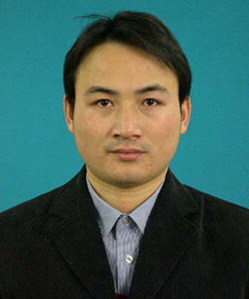
Gongnan Xie
Gongnan Xie has been a Full Professor since 2014 in Northwestern Polytechnical University, Xi’an, China. He received his Ph.D. degree in 2007 from the School of Energy and Power Engineering in Xi’an Jiaotong University, Xi’an, China, and then was a Postdoctoral Fellow from 2008 to 2009 at the Department of Energy Sciences in Lund University, Lund, Sweden. He was a Visiting Professor from 2016 to 2017 at the Department of Mechanical Engineering in University of Minnesota, Twin Cities, USA. He is a member of Scientific Council of International Center of Heat and Mass Transfer, and a Committee Member of ASME K14, K10, K9. He currently serves as an Associate Editor or a member of Editorial Board for several journals. He served as an Associate Editor for ASME Journal of Heat Transfer (2014–2020). His main interests are gas turbines heat transfer and cooling, supercritical fluids flow and heat transfer, microchannel cooling, renewable energy, heat exchangers and optimization design.
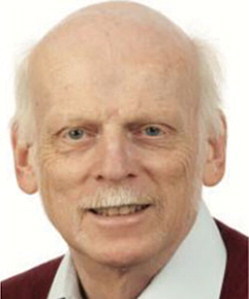
Bengt Sundén
Bengt Sundén received his M.Sc. in Mechanical Engineering 1973, Ph.D. in Applied Thermodynamics and Fluid Mechanics 1979, became Docent in Applied Thermodynamics and Fluid Mechanics 1980, all at Chalmers University of Technology, Göteborg, Sweden. He was Professor of Heat Transfer, Lund University, Lund, Sweden 1992–2016, Head Department of Energy Sciences, Lund University, Lund, Sweden for 21 years, 1995–2016. He serves as Professor Emeritus and Senior Professor in Heat Transfer since 2016-10-01. The research activities cover compact heat exchangers, heat transfer enhancement, gas turbine heat transfer, combustion-related heat transfer including thermal radiation, CFD-methods, liquid crystal thermography, condensation and evaporation on micro-nanostructured surfaces, nanofluids, impinging jets, aerospace heat transfer, computational modeling and analysis of multiphysics and multiscale phenomena for fuel cells, thermal management of batteries. He was founding and first editor-in-chief IJHEX – International Journal of Heat Exchangers (R.T. Edwards Inc., USA) 1999–2008, Associate Editor ASME J. Heat Transfer 2005–2008, Editor-in-Chief Book Series – Developments in Heat Transfer (WIT Press, UK), 1995, published more than 900 papers in journals (> 600), books, and proceedings. He is a Fellow of ASME, Honorary Professor Xi’an Jiaotong Univ., China, Guest Professor Northwestern Polytechnical Univ., Xi’an, China, Guest Professor Harbin Institute of Technology, Harbin, China, Honorary Professor Hebei University of Technology, Tianjin, China, 2011 Recipient of ASME Heat Transfer Memorial Award, 2013 recipient of ASME Heat Transfer Division 75th Anniversary Medal, Donald Q. Kern Award 2016, 2023 recipient of AIAA Energy Systems Award, Regional editor Journal of Enhanced Heat Transfer 2007, Associate editor J. Heat Transfer Research 2011, Associate editor ASME J. Thermal Science, Engineering and Applications 2010–2016, Associate editor ASME J. Electrochemical Energy Conversion and Storage 2017–2023.
References
- V. Smil, Natural Gas: Fuel for the 21st Century, United Kingdom: John Wiley & Sons, 2015,
- D.-H. Lee, M.-K. Ha, S.-Y. Kim and S.-C. Shin, “Research of design challenges and new technologies for floating LNG,” Int. J. Nav. Archit. Ocean Eng., vol. 6, no. 2, pp. 307–322, Jun. 2014. DOI: 10.2478/IJNAOE-2013-0181.
- Q. Jiang, et al., “Adaptive design methodology of segmented non-uniform fin arrangements for trans-critical natural gas in the printed circuit heat exchanger,” Appl. Therm. Eng., vol. 216, pp. 119011, Nov. 2022. DOI: 10.1016/j.applthermaleng.2022.119011.
- D. Popov, et al., “Cryogenic heat exchangers for process cooling and renewable energy storage: a review,” Appl. Therm. Eng., vol. 153, pp. 275–290, May 2019. DOI: 10.1016/j.applthermaleng.2019.02.106.
- S. Jeon, Y.-J. Baik, C. Byon and W. Kim, “Thermal performance of heterogeneous PCHE for supercritical CO2 energy cycle,” Int. J. Heat Mass Transf., vol. 102, pp. 867–876, Nov. 2016. DOI: 10.1016/j.ijheatmasstransfer.2016.06.091.
- M. Chen, et al., “Pressure drop and heat transfer characteristics of a high-temperature printed circuit heat exchanger,” Appl. Therm. Eng., vol. 108, pp. 1409–1417, Sep. 2016. 2016.07.149. DOI: 10.1016/j.applthermaleng.
- T. Ma, L. Li, X.-Y. Xu, Y.-T. Chen and Q.-W. Wang, “Study on local thermal-hydraulic performance and optimization of zigzag-type printed circuit heat exchanger at high temperature,” Energy Convers. Manag., vol. 104, pp. 55–66, Nov. 2015. DOI: 10.1016/j.enconman.2015.03.016.
- T. L. Ngo, Y. Kato, K. Nikitin and N. Tsuzuki, “New printed circuit heat exchanger with S-shaped fins for hot water supplier,” Exp. Therm. Fluid Sci., vol. 30, no. 8, pp. 811–819, 2006. Aug. DOI: 10.1016/j.expthermflusci.2006.03.010.
- Y.-J. Baik, S. Jeon, B. Kim, D. Jeon and C. Byon, “Heat transfer performance of wavy-channeled PCHEs and the effects of waviness factors,” Int. J. Heat Mass Transf., vol. 114, pp. 809–815, Nov. 2017. DOI: 10.1016/j.ijheatmasstransfer.2017.06.119.
- J. Lian, et al., “Thermal and mechanical performance of a hybrid printed circuit heat exchanger used for supercritical carbon dioxide Brayton cycle,” Energy Convers. Manag., vol. 245, pp. 114573, Oct. 2021. DOI: 10.1016/j.enconman.2021.114573.
- H. Chang, J. Lian, T. Ma, L. Li and Q. Wang, “Design and optimization of an annular air-hydrogen precooler for advanced space launchers engines,” Energy Convers. Manag., vol. 241, pp. 114279, Aug. 2021. DOI: 10.1016/j.enconman.2021.114279.
- T. Ma, et al., “Thermal-hydraulic characteristics of printed circuit heat exchanger used for floating natural gas liquefaction,” Renew. Sust. Energ. Rev., vol. 137, pp. 110606, Mar. 2021. DOI: 10.1016/j.rser.2020.110606.
- D. E. Kim, M. H. Kim, J. E. Cha and S. O. Kim, “Numerical investigation on thermal-hydraulic performance of new printed circuit heat exchanger model,” Nucl. Eng. Des., vol. 238, no. 12, pp. 3269–3276, Dec. 2008. DOI: 10.1016/j.nucengdes.2008.08.002.
- N. Tsuzuki, Y. Kato and T. Ishiduka, “High performance printed circuit heat exchanger,” Appl. Therm. Eng., vol. 27, no. 10, pp. 1702–1707, Jul. 2007. 2006.07.007. DOI: 10.1016/j.applthermaleng.
- S. H. Yoon, H. C. No and G. B. Kang, “Assessment of straight, zigzag, S-shape, and airfoil PCHEs for intermediate heat exchangers of HTGRs and SFRs,” Nucl. Eng. Des., vol. 270, pp. 334–343, Apr 2014. DOI: 10.1016/j.nucengdes.2014.01.006.
- T. Ma, et al., “Effect of fin-endwall fillet on thermal hydraulic performance of airfoil printed circuit heat exchanger,” Appl. Therm. Eng., vol. 89, pp. 1087–1095, Oct. 2015. DOI: 10.1016/j.applthermaleng.2015.04.022.
- W.-X. Chu, X.-H. Li, T. Ma, Y.-T. Chen and Q.-W. Wang, “Study on hydraulic and thermal performance of printed circuit heat transfer surface with distributed airfoil fins,” Appl. Therm. Eng., vol. 114, pp. 1309–1318, Mar. 2017. 2016.11.187. DOI: 10.1016/j.applthermaleng.
- X. Cui, et al., “Numerical study on novel airfoil fins for printed circuit heat exchanger using supercritical CO2,” Int. J. Heat Mass Transf., vol. 121, pp. 354–366, Jun. 2018. DOI: 10.1016/j.ijheatmasstransfer.2018.01.015.
- W.-X. Chu, K. Bennett, J. Cheng, Y.-T. Chen and Q.-W. Wang, “Thermo-hydraulic performance of printed circuit heat exchanger with different cambered airfoil fins,” Heat Transf. Eng., vol. 41, no. 8, pp. 708–722, 2020. DOI: 10.1080/01457632.2018.1564203.
- U. Kashyap, K. Das and B. K. Debnath, “Effect of surface modification of a rectangular vortex generator on heat transfer rate from a surface to fluid: an extended study,” Int. J. Therm. Sci, vol. 134, pp. 269–281, Dec. 2018. DOI: 10.1016/j.ijthermalsci.2018.08.020.
- M. Li, J. Qu, J. Zhang, J. Wei and W. Tao, “Air side heat transfer enhancement using radiantly arranged winglets in fin-and-tube heat exchanger,” Int. J. Therm. Sci., vol. 156, pp. 106470, Oct. 2020. DOI: 10.1016/j.ijthermalsci.2020.106470.
- G. Zhou and Z. Feng, “Experimental investigations of heat transfer enhancement by plane and curved winglet type vortex generators with punched holes,” Int. J. Therm. Sci., vol. 78, pp. 26–35, Apr. 2014. DOI: 10.1016/j.ijthermalsci.2013.11.010.
- T. T. GöKsu and R. Behçet, “Experimental investigation of the effect of a novel curved winglet vortex generator on heat transfer with a designed controller circuit,” Int. J. Therm. Sci., vol. 180, pp. 107724, Oct. 2022. DOI: 10.1016/j.ijthermalsci.2022.107724.
- Y. Oh and K. Kim, “Effects of position and geometry of curved vortex generators on fin-tube heat-exchanger performance characteristics,” Appl. Therm. Eng., vol. 189, pp. 116736, May 2021. DOI: 10.1016/j.applthermaleng.2021.116736.
- K. W. Song, et al., “Thermal-hydraulic characteristic of a novel wavy fin-and-circle tube heat exchanger with concave curved vortex generators,” Int. J. Heat Mass Transf., vol. 194, pp. 123023, Sep. 2022. DOI: 10.1016/j.ijheatmasstransfer.2022.123023.
- D. L. Hu, et al., “Performance optimization of a wavy finned-tube heat exchanger with staggered curved vortex generators,” Int. J. Therm. Sci., vol. 183, pp. 107830, Jan. 2023. DOI: 10.1016/j.ijthermalsci.2022.107830.
- X. Xu, et al., “Optimization of fin arrangement and channel configuration in an airfoil fin PCHE for supercritical CO2 cycle,” Appl. Therm. Eng., vol. 70, no. 1, pp. 867–875, Sep. 2014. DOI: 10.1016/j.applthermaleng.2014.05.040.
- F. R. Menter, “Two-Equation Eddy-Viscosity turbulence models for engineering applications,” AIAA J., vol. 32, no. 8, pp. 1598–1605, Aug. 1994. DOI: 10.2514/3.12149.
- C. Liu, et al., “Experimental investigations on liquid flow and heat transfer in rectangular microchannel with longitudinal vortex generators,” Int. J. Heat Mass Transf., vol. 54, no. 13–14, pp. 3069–3080, Jun. 2011. DOI: 10.1016/j.ijheatmasstransfer.2011.02.030.
- L.-H. Tang, J. Pan and B. Sundén, “Investigation on thermal-hydraulic performance in a printed circuit heat exchanger with airfoil and vortex generator fins for supercritical liquefied natural gas,” Heat Transf. Eng., vol. 42, no. 10, pp. 803–823, 2021. DOI: 10.1080/01457632.2020.1744244.
- Y. L. He, H. Han, W. Q. Tao and Y. W. Zhang, “Numerical study of heat-transfer enhancement by punched winglet-type vortex generator arrays in fin-and-tube heat exchangers,” Int. J. Heat Mass Transf., vol. 55, no. 21–22, pp. 5449–5458, Oct. 2012. DOI: 10.1016/j.ijheatmasstransfer.2012.04.059.
- M. Zeng, L. H. Tang, M. Lin and Q. W. Wang, “Optimization of heat exchangers with vortex-generator fin by Taguchi method,” Appl. Therm. Eng., vol. 30, no. 13, pp. 1775–1783, Sep. 2010. DOI: 10.1016/j.applthermaleng.2010.04.009.
- P. A. Eibeck and J. K. Eaton, “Heat transfer effects of a longitudinal vortex embedded in a turbulent boundary layer,” ASME,” J. Heat Transfer, vol. 109, no. 1, pp. 16–24, Feb. 1987. DOI: 10.1115/1.3248039.

